Thoughts on Westmount Park
and the latest renewal project
We can only hope for judicious repairs to the park rather than major “improvements”
By David Nercessian
November 11, 2021
In the recent discussions on the fate of Westmount Park, I’m surprised by the absence of comments from people who remember it before the last major renovation in 1964. I never considered myself old until a twenty-something kindly offered me her seat in the metro about ten years ago. “Do I look that decrepit?” I asked myself and confirmed it by accepting her offer.
When I was ten, Westmount Park was vastly “improved” and now, as my almost-seventieth year beckons, the park faces a new round of improvements. From the mouth of city hall, the word “improvement” is liable to cause consternation among the citizenry. It seems the main problem with Westmount Park isn’t that it’s defective, rather a lack of maintenance has allowed it to become shabby. The “cure” for shabbiness in 1964 was strong medicine, so I hope we aren’t in for something similar.
I have included some post-card views of the early days and photos in the Conrad Poirier collection, taken mainly in the late 30s to mid-40s. The large piece of twentieth-century artillery that appears in one, I believe, was on display only during the war. I include a family photo, as well, and a pertinent section of the series of aerial photos taken of the Island of Montreal c. 1947. I marked the bandstand as “A” and the stone bridge as “B.”
It seems the main problem with Westmount Park isn’t that it’s defective, rather a lack of maintenance has allowed it to become shabby. The “cure” for shabbiness in 1964 was strong medicine, so I hope we aren’t in for something similar.
As small children in the late 50s, my sisters and I were taken to the park and enjoyed using the swings. My father caught me looking a bit pensive in May ’59. Back then, it was de rigueur to feed the ducks dry bread, and they were white domestic ducks brought in each spring.
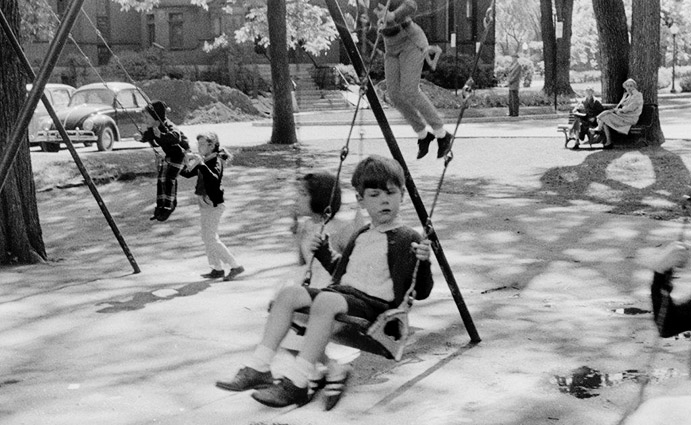
David Nercessian on swing in Westmount Park (May 1959) – Image: courtesy of David Nercessian
We would climb the steps of the Victorian bandstand, and our parents discouraged us from walking along the bench that lined its perimeter. But we attempted to do so anyway. No visit to the park was complete without clambering onto one of the cannon and straddling the barrel. The brass was bright where countless children had done the same.
The flat area of the park near Sherbrooke Street retained its tall elms before Dutch elm disease claimed them one by one. Also, around 1959, a thrifty city installed large concrete culverts in the playground to climb through and over. Large spots were painted on their outer walls but our parents wouldn’t allow us to go inside due to the polio epidemic afflicting the city.
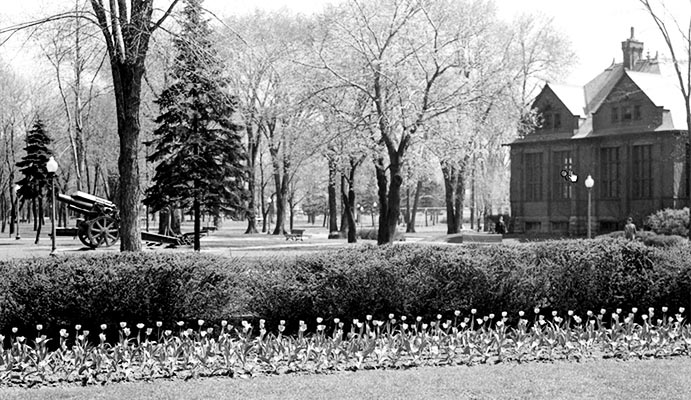
Artillery on display in the park by the Westmount Library – Image: Conrad Poirier, BAnQ, Public Domain
At about the same time, the Children’s Library was added to the original structure. I remember the strong smell of new linoleum and the wide round reading table specially built. It occupied the space near the big window that looked out on the south side and was surrounded by small chairs. The friendly librarian, Miss Fraser, noticed the address on our library cards and told us she had lived in our house on Elm Avenue years earlier.
‘… woe betide the small boy daring to launch a boat in the main pond. Westmount Police patrolled the park in those days, and their orders were to be obeyed.’
When I was a bit older, I would go to the park with a friend to sail our boats on the sailing pond at Melville. The impressive granite fountain there had basins for horses and dogs and never worked in my experience, but it had authority and looked permanent. But woe betide the small boy daring to launch a boat in the main pond. Westmount Police patrolled the park in those days, and their orders were to be obeyed.
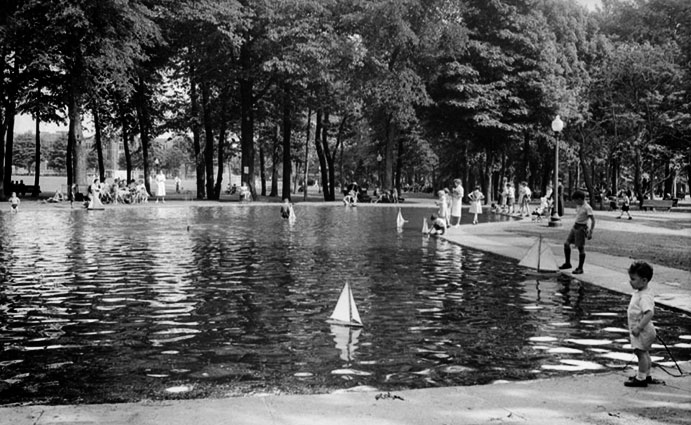
Sailing pond near Melville in Westmount Park (1938) – Image: Conrad Poirier, BAnQ, Public Domain
Still, later I would cross the park on the way to music lessons after school and especially on damp late-winter afternoons, the yeasty aroma of fresh bread blanketed the park from the POM bakery on St. Catherine Street. That was a few years before the construction of the Ville Marie expressway, so there was no background roar of the highway. But during the afternoon rush hour, any southerly winds would amplify the growl of Canadian Pacific’s first-generation diesel locomotives pounding up the hill from Windsor Station. Commuter trains made their first stop at Westmount Station at the foot of Victoria Avenue on their way to the Lakeshore or Rigaud.
‘… I would cross the park on the way to music lessons after school and especially on damp late-winter afternoons, the yeasty aroma of fresh bread blanketed the park from the POM bakery on St. Catherine Street.’
Any pedestrian in the park knew when southwesterly winds blew, especially during winter temperature inversions with low cloud ceilings: the air was heavy with the sulphurous effluent of La Salle Coke. The plant still actively converted bituminous coal to coke and town-gas down on the Lachine Canal.
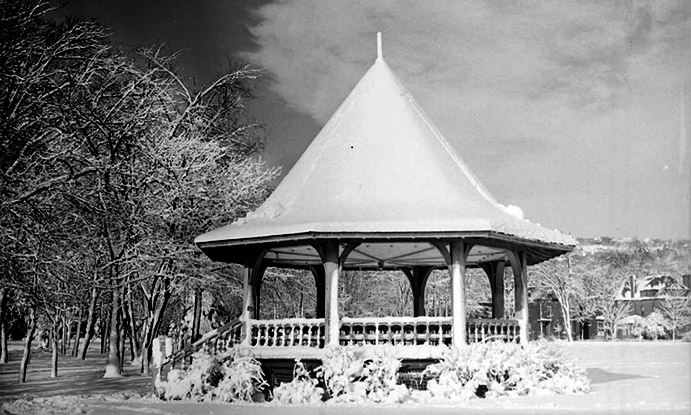
Victorian bandstand in Westmount Park on a winter’s day – Image: Conrad Poirier, BAnQ, Public Domain
The 1964 park renovation project was one of “modernization” : it tore down the bandstand and removed the granite fountain at the corner of Melville. It did away with the substantial stone bridge built in the Depression and modified the ravine area beyond recognition. Admittedly scruffy then, it was modified with what are now dark slimy stone walls and screens of rampant wild grapevines. The Depression-era pond was altered by implanting a very artificial waterfall. It would actually look graceful next to a mid-60s office building. Before the waterfall was built, it was possible to walk completely around the pond. To do so now would entail scaling concrete parapets and chain-link fencing.
‘ The Depression-era pond was altered by implanting a very artificial waterfall. It would actually look graceful next to a mid-60s office building.’
In the 1964 remaking, all the paths of the park were torn out. They had a natural, angular A to B to C layout but were rebuilt in today’s peculiar pattern with gentle, very artificial curves inspired by the US Interstate Highway system. A major blunder then was to excavate main new paths in cuttings with no drainage, as can be seen in front of the comfort station. The paths come together at the low bridge by the pond, and when it rains, turn into watercourses. During spring runoff, quantities of salt and sand are needed every year to control the accumulation of ice and without fail we’re required to scramble goat-like up the banks or tiptoe along the sides of the bridge approaches to avoid stepping into deep water.
‘A major blunder then was to excavate main new paths in cuttings with no drainage, as can be seen in front of the comfort station. The paths come together at the low bridge by the pond, and when it rains, turn into watercourses.’
The first bridge, built after the 1964 project, was made of wood and rotted away after a few years. Many of the park’s old-fashioned but comfortable semi-movable benches with dark green wooden slats and cast-iron ends were banished and replaced by permanent wooden ones of vertically-oriented wooden slats, painted brown. They rotted away fairly quickly too though many of the 1964 concrete bases are still in use under new planks. Certain areas were paved with bricks of the same colour but over the years many chipped or were picked up by plows. Most remaining areas were asphalted over recently for safety reasons.
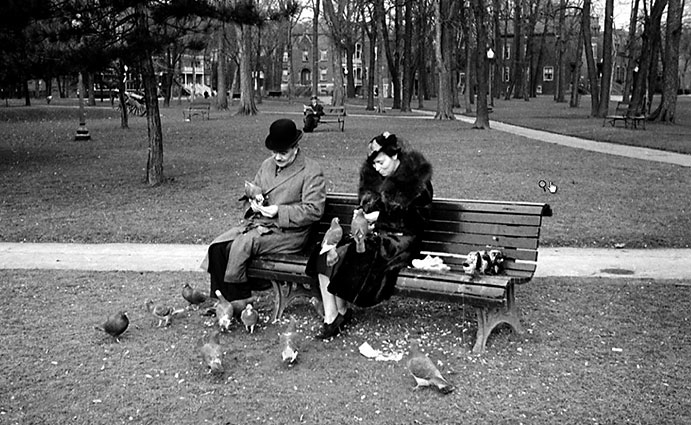
Original Westmount Park benches (1938) – Image: Conrad Poirier, BAnQ, Public Domain
In the brochure describing the proposed improvements, there’s an almost accusatory photo of one of the park’s signature Washingtonian lamps, which suggests they are doomed. What is to replace them isn’t revealed.
If the pond is leaking, it will need attention. It’s built over the Glen creek, so there must be rock ledge and fissures beneath it, which naturally drain anything above. When the new underground arena was built a ‘mysterious’ pipe was discovered, which had a permanent flow of water. No doubt the pipe had been installed when the Glen creek was covered over in that spot as long ago as 1900.
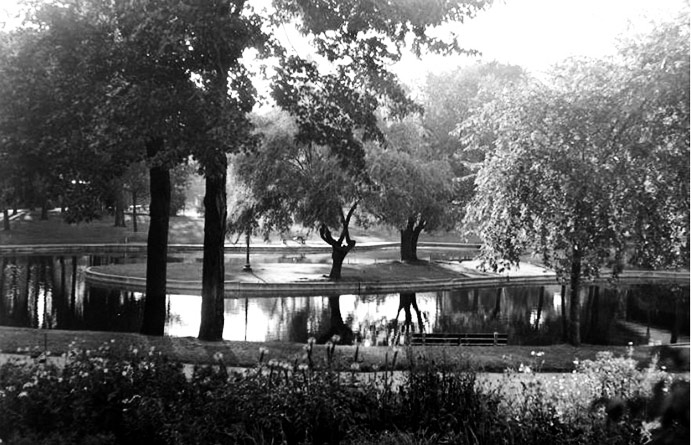
Willows on the lagoon at Westmount Park (1949) – Image: Conrad Poirier, BAnQ Public Domain
The Poirier photos show more than one willow tree and the city had tried hard to preserve the beloved one that eventually needed horizontal support. But a willow is notoriously thirsty and, despite the beauty of form, is probably not a good choice to plant near an artificial pond built over a natural drain. Willow roots dry out the soil, and the concrete floor of a pool situated above will fracture. Plastic liners are no match for willow roots either and will be penetrated. Any damage to the concrete or polymer liner by tree roots will help feed the subterranean Glen creek. If the pond was located in an impervious clay bed, root penetration would be of less concern.
‘… a willow is notoriously thirsty and… is probably not a good choice to plant near an artificial pond built over a natural drain. Willow roots dry out the soil, and the concrete floor of a pool situated above will fracture.’
Back when de Maisonneuve was blocked to motor traffic and the new bike path designed, the majority of cyclists were just out enjoying a ride rather than commuting, so it was made to meander. It now has a lot of traffic from regular and electric bicycles and scooters. Unfortunately, the current design of the western end encourages pedestrians to take it as a shortcut walking east from Lansdowne. So that, as well as the leaking pond, needs to be addressed.
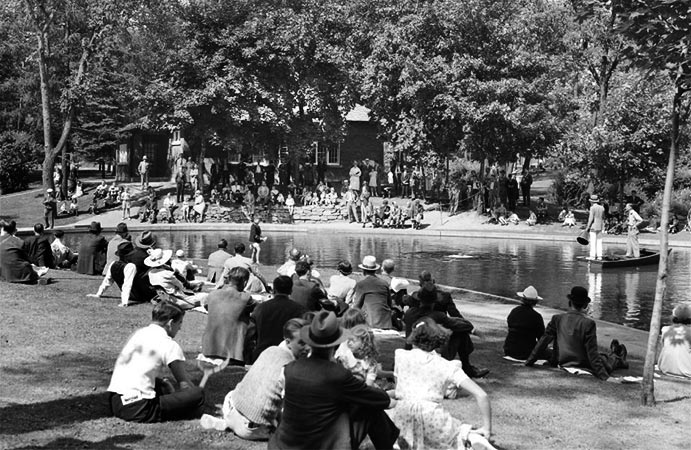
Angler’s competition in the lagoon at Westmount Park (1938) – Image: Conrad Poirier, BAnQ, Public Domain
The time of the last park make-over was one of radical urban change. “Urban renewal” and “progress” were used to describe the wholesale demolition of neighbourhoods. Westmount Park’s bandstand was considered old-fashioned and not worth repairing. In 1964, the destruction of Lower Westmount was underway, and all the houses on the north side of Dorchester and Tupper Streets were bulldozed. Orange and Black “Teperman Demolition” signs were encountered throughout lower Westmount and the Square Mile. Even more houses below Sherbrooke would be demolished and replaced by high-rise apartments if the city’s plans had been carried further.
‘… installing “skyways” in Westmount Park likely wouldn’t run too closely to Olmsted’s idea of admiring nature for what it is and embellishing it with perspectives.’
I don’t know how close Stantec‘s philosophy is to that of Frederick Olmsted. But to me, installing “skyways” in Westmount Park likely wouldn’t run too closely to Olmsted’s idea of admiring nature for what it is and embellishing it with perspectives. It seems the “skyways” idea might have been abandoned now, but we can only hope for judicious repairs to the park rather than major “improvements.”
Disclaimer: The opinions expressed in this article are those of the author and do not necessarily reflect the opinions of WestmountMag.ca or its publishers.
Feature image: old stone bridge over Glen creek (1938), BAnQ, Public Domain
Other articles about Westmount Park

About David Nercessian – I was born in the erstwhile Children’s Hospital, then still the Western Division of the Montreal General. My family lived on Elm Avenue until 1960 when we moved to Rosemount Avenue. Except for a year in Algeria and four downtown, I’ve otherwise lived in Westmount.

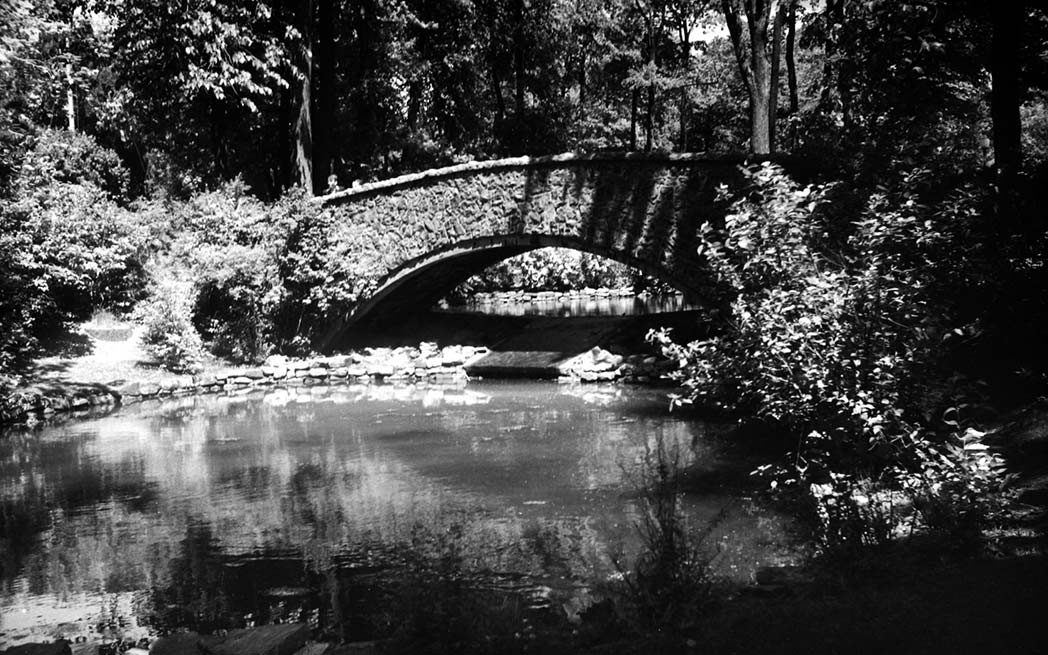
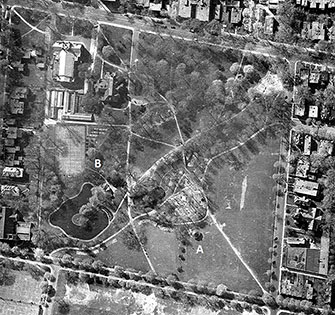
Lived on Western between Melville and Metcalfe from 1941 to about 1950 and then Victoria Ave to 1962 when the Lakeshore became home. So much of the article strikes home. I thought and still think that the 1964 “makeover” was ruinous. Thanks for the article which brings back so many good memories.
This is an article that was not only a joy to read, but I am in agreement with many of the points. The main park in my hometown of Rugby, England has had a few changes since I first ventured in as a toddler nearly 60 years ago, but upon each return, it looks familiar with the changes barely noticeable. A result of excellent British landscaping. Those in charge of Westmount Park have been severely criticized for allowing the park to fall into its “shabby” state. Yes, an argument could be made that the leadership was lacking, but the people of Westmount share most of the blame for being too reactionary as opposed to proactive on this and other dossiers. Stantec has failed to convince me that its plans are a good fit for Westmount Park. I hold the opinion that the broken parts of the park should be fixed but it should remain very much as is. Then there is the cost of the Stantec plan. With streets like Claremont, The Boulevard, Edgehill, Sherbrooke, Victoria and others having spots so rough that NASA could endurance test its Mars rover, I share the opinion that our long-neglected streets need to be made to be less “shabby” first. I fear that the low voter turnout in last week’s municipal election is an indicator of civic apathy which could result in a council that either gives us more tepid and uninspired leadership or embarks on a course that will get the attention from the electorate only when it is too late to stop what it may disagree with. Westmount Park’s future needs a healthier discussion among all Westmounters, not just the engaged, caring, vocal and few.
This article brings back many great memories.I spent a lot of time in this park..mostly in the early 50’s. Listed below are some of my best memories.
Concerts at the bandstand..some featuring the RMR band.
Yearly event when stargazers brought their large telescopes to allow us to see the stars.
Sailing my homemade boat in the lake near Sherbrooke Street.
The area with swings and merry go round.
The washroom buildings where police usually had one member posted.
In winter skating on the rink in lake near Western Avenue,
Watching seniors playing checkers with large pieces provided by the City of Westmount.
Watching football games on large playing on field on East side of park.
Going to the Library located on West side of park.
I really enjoyed this article..I lived one street over from where the author lived.Hopefully other residents who enjoyed the article will add some comments.
Alfred
November 22,2021